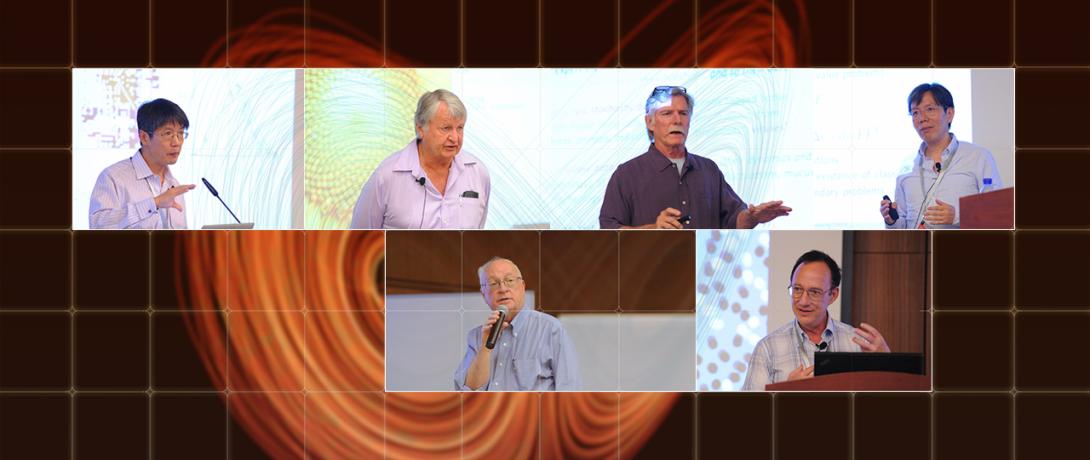From June 8-10, 2015, NYU Shanghai hosted the International Conference on Mathematics of Nonlinearity in Neural and Physical Science, bringing together some of the world’s top researchers to discuss and understand the role of nonlinearity in neural and physical science. The gathering was the first to be co-sponsored by two NYU-ECNU Research Institutes at NYU Shanghai: the Institute of Mathematical Sciences and the Institute of Brain and Cognitive Science.
“The conference brings together world class researchers interested in understanding different phenomena in Nature, and in applying their cutting edge knowledge of mathematics to understand the world around them,” said Richard McLaughlin, member of this conference’s scientific committee.
The two and a half days of presentations and talks focused on the advances of the mathematics of nonlinearity and its direct and powerful application to some of the most important challenges of our time, in line with China’s science and innovation priority of “strongly promote interdisciplinary research work.”
World-class speakers
The conference was led by a panel of seven distinguished professors in neural and physical science and mathematics, four of whom are also Affiliated Professors of NYU Shanghai: Professors David Cai, M. Gregory (Greg) Forest, Fanghua Lin, Kenneth McLaughlin, Richard McLaughlin, Charles Newman, and Xiao-Jing Wang.

The conference attracted 25 outstanding international speakers from leading universities and research institutes, including NYU Shanghai and Shanghai Jiao Tong University, Fudan University, Peking University, the Massachusetts Institute of Technology (MIT), University of Michigan, New York University (NYU), University of Illinois at Urbana-Champaign, University of North Carolina at Chapel Hill, Paris Descartes University (Paris 5), Princeton University, and the French National Centre for Scientific Research (CNRS). Ph.D. students, post-docs, and junior faculty attended alongside senior distinguished faculty.
Interdisciplinary platform
The conference served as an interdisciplinary platform to promote exchange among the various research fields. “It is exciting to observe the mathematics developed for Neural Science being used to help understand current open questions in totally different areas of science, and vice versa. This is an illustration of the universal nature of mathematics and underscores the motivation to bring this diverse group of mathematical scientists together,” mathematics professor Greg Forest said.
He also pointed out the long-term goals of the researchers at this meeting: to extract the fundamental principles behind how the brain and diverse physical and biological systems work, to develop the mathematical and computational tools necessary to explain these principles and gain predictive power from them, and to carry these intellectual advances to practical applications.
A sample of questions addressed in the conference includes: Can our knowledge of the mechanisms of vision, attention, and learning help medical scientists reinstate vision for the blind and guide remedies for attention deficit disorders and learning disabilities? What kind of mathematics is needed to describe extraordinarily complex neural circuits and help us understand the brain mechanisms of cognitive processes such as how we make choices in decision-making? Can our knowledge of the mechanisms of how epileptic seizures are triggered and propagate in the brain lead to new procedures to prevent seizures or reduce their severity? Where do pollutants released in Nature either by human behavior (e.g., oil spills) or natural events (e.g., volcanoes) get transported or trapped in the atmosphere, ocean, or subsurface soil? Is there a rational design behind the growth patterns observed in plants, e.g., the robust spiral patterns of sunflower seeds?
Waves are everywhere in Nature, and it turns out that beautiful new mathematics has emerged that reflects the underlying structures observed in huge “rogue” waves in the open waters of oceans and channels, light propagation in optical fiber transmission lines, and even vortex filaments (the equivalent of smoke rings except in water). Quite amazingly, the mathematical techniques developed to understand these wave phenomena are essentially identical, again revealing the universal nature of mathematics, and the reason for conferences such as this one to seek cross-fertilization among scientists and mathematicians.
Carrying on the tradition
One of the highlights of the meeting was the celebration in honor of NYU Provost David McLaughlin, a scholar, collaborator, mentor, and institutional leader, who made great contributions in the mathematics of nonlinearity in neural and physical science.
Reflecting on NYU’s reputation within the scientific community and its remarkable achievements in applied mathematics, Forest said, “We would like to communicate to the public and the academic community that whereas NYU and the Courant Institute is the recognized “temple of applied mathematics”, the aspiration of the NYU global university is to build a new temple in NYU Shanghai. Forest added that the conference was conceived to celebrate advances thus far while highlighting the challenges ahead, and especially to guide young scholars in their future research directions.
Furthermore, Xiao-Jing Wang, Associate Vice Chancellor for Research at NYU Shanghai and Director of the NYU-ECNU Institute of Brain and Cognitive Science at NYU Shanghai, pointed out that the conference was also an opportunity to highlight research activities at NYU Shanghai.
“Our vision is to build NYU Shanghai as a top research university, not only a college for undergraduate studies. Applied Mathematics and Neuroscience are two focused areas of our research development at NYU Shanghai. This conference exemplifies the kind of high-level cross-disciplinary scientific research and international collaboration at the core of our mission,” Wang said.


